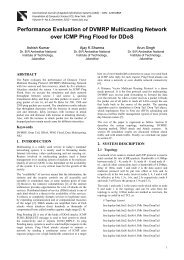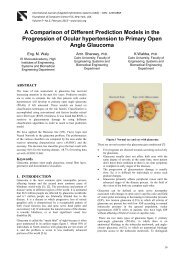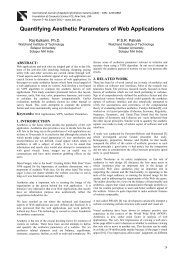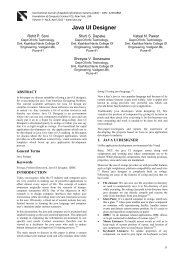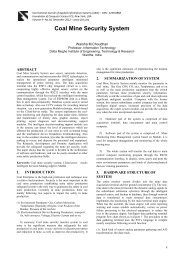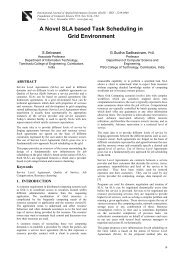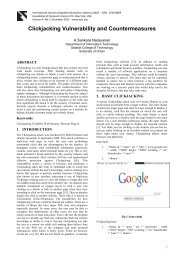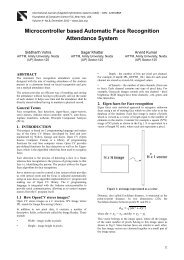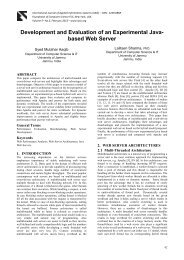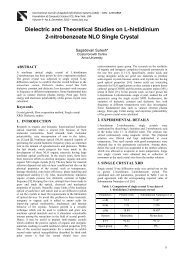y - International Journal of Applied Information Systems
y - International Journal of Applied Information Systems
y - International Journal of Applied Information Systems
Create successful ePaper yourself
Turn your PDF publications into a flip-book with our unique Google optimized e-Paper software.
<strong>International</strong> <strong>Journal</strong> <strong>of</strong> <strong>Applied</strong> <strong>Information</strong> <strong>Systems</strong> (IJAIS) – ISSN : 2249-0868<br />
Foundation <strong>of</strong> Computer Science FCS, New York, USA<br />
Volume 4– No.7, December 2012 – www.ijais.org<br />
*<br />
The x -axis is taken along the plate in the vertically upward<br />
*<br />
direction and the y -axis is taken normal to the plate.<br />
Initially the plate and the fluid are at the same temperature<br />
*<br />
*<br />
T in the stationary condition with concentration level<br />
at all points. At time,<br />
accelerated with a velocity<br />
C <br />
*<br />
t 0 , the plate is exponentially<br />
**<br />
* at<br />
o<br />
u U e<br />
in its own plane<br />
and the temperature <strong>of</strong> the plate is raised at a uniform rate and<br />
the level <strong>of</strong> concentration near the plate is raised linearly with<br />
time. All the physical properties <strong>of</strong> the fluid are considered to<br />
be constant. The unsteady flow is governed by the following<br />
equations:<br />
* 2 *<br />
u u<br />
g T T g C C<br />
* *2<br />
t y<br />
* 2 *<br />
C C<br />
D K C C<br />
* *2<br />
t y<br />
Tk T Q<br />
t y <br />
* * * * *<br />
<br />
* * *<br />
*<br />
* T T<br />
* 2 *<br />
* <br />
C *2<br />
0<br />
C<br />
<br />
The initial and boundary conditions relevant to the fluid flow<br />
are:<br />
* * * * * *<br />
t* 0 : u 0, T T , C C For all y <br />
<br />
*<br />
<br />
**<br />
* at T<br />
q * * * <br />
t* 0 : u U e , , C C at y 0<br />
o *<br />
w <br />
y<br />
k<br />
<br />
* * * * * *<br />
u 0, T T , C C as y <br />
<br />
(4)<br />
*<br />
*<br />
*<br />
Where u is the axial velocity, t is time, T the fluid<br />
*<br />
temperature, is coefficient <strong>of</strong> volume, C is the fluid<br />
concentration,<br />
(1)<br />
(2)<br />
(3)<br />
*<br />
C w is wall concentration, D the mass<br />
*<br />
is the<br />
diffusivity, K is chemical reaction parameter,<br />
coefficient <strong>of</strong> concentration expansion.<br />
3. ANALYTICAL SOLUTION<br />
To solve the governing equations in dimensionless form, the<br />
following non-dimensional quantities were introduced:<br />
* * * 2<br />
y U0 u t U0 Q<br />
0<br />
y , U , t ,, F 2 <br />
U0 cU<br />
0 <br />
* * * * *<br />
T T C C a <br />
, c , a,<br />
<br />
* * 2<br />
q k Cw CU0 <br />
*<br />
(5)<br />
K c<br />
K , Sc ,Pr , <br />
2<br />
U0 D k<br />
<br />
<br />
2<br />
* * *<br />
gq g CwC Gr , Gc 4 3 <br />
kU 0 U0<br />
<br />
The governing equations on using (5) into (1) to (4) reduce to<br />
the following<br />
2<br />
u u<br />
Nc<br />
2<br />
t y<br />
<br />
tScy 2<br />
c 1 c<br />
Kc<br />
2<br />
2<br />
1 <br />
F<br />
2<br />
t Pr y<br />
Subject to the boundary conditions<br />
For t 0: u c 0,<br />
<br />
<br />
t <br />
for 0 y 1<br />
at ue , 1,<br />
y<br />
u 0, 0, c 0<br />
For 0:<br />
c 1 at y 0<br />
, as y <br />
To obtain the solutions, we apply the Laplace transform to (6)<br />
– (8) and the boundary conditions to get<br />
2<br />
d <br />
Pr 2 PF 0<br />
(9)<br />
dy<br />
2<br />
dC<br />
Sc 2 P K C<br />
dy<br />
(6)<br />
(7)<br />
(8)<br />
0<br />
(10)<br />
2<br />
dU<br />
PU NC<br />
2<br />
dy<br />
(11)<br />
The boundary conditions are<br />
t 0 : U C 0, y 1<br />
<br />
<br />
1 d<br />
1 1 <br />
t 0 : U , , C , at y 0<br />
P a dy P P <br />
U 0, 0, C 0, as y <br />
<br />
The solutions to (9) to (11) subject to (12) give<br />
(<br />
y, p)<br />
<br />
e<br />
C( y, p)<br />
<br />
Pr<br />
e<br />
k1<br />
y Z<br />
Z F<br />
k2Z<br />
Z K<br />
Z<br />
(12)<br />
(13)<br />
(14)<br />
22



